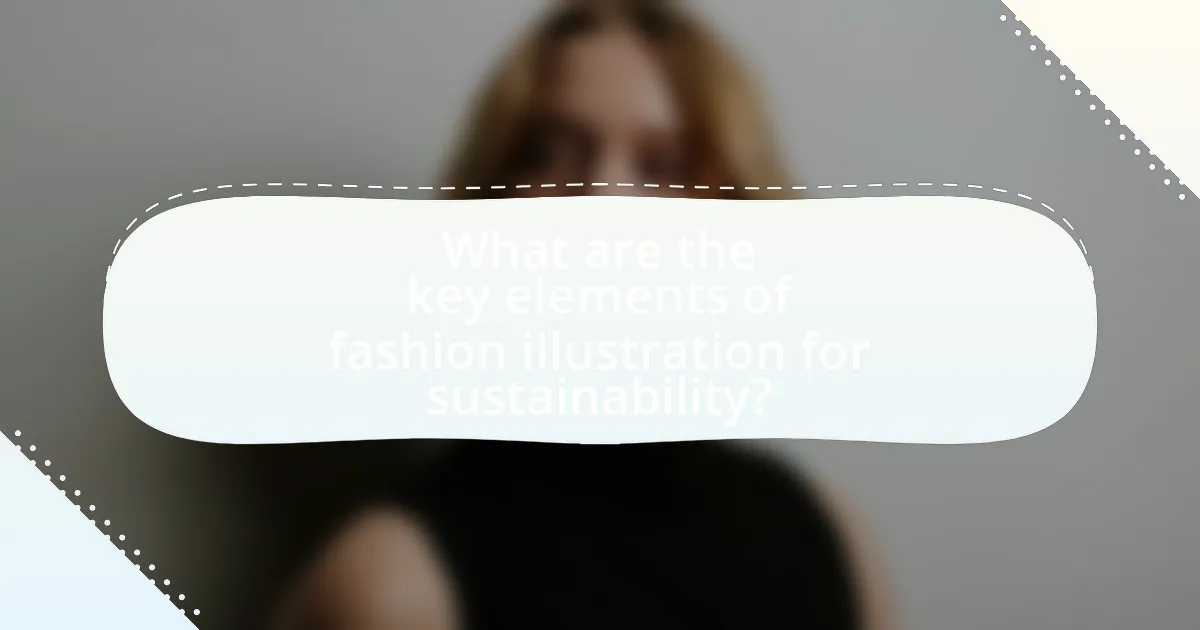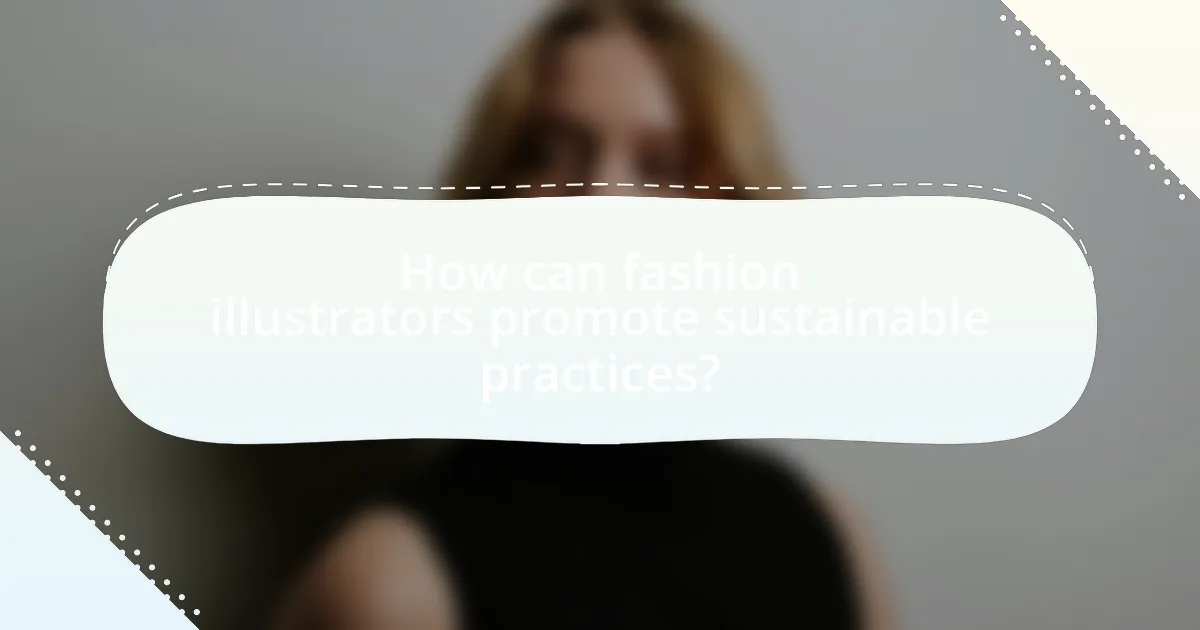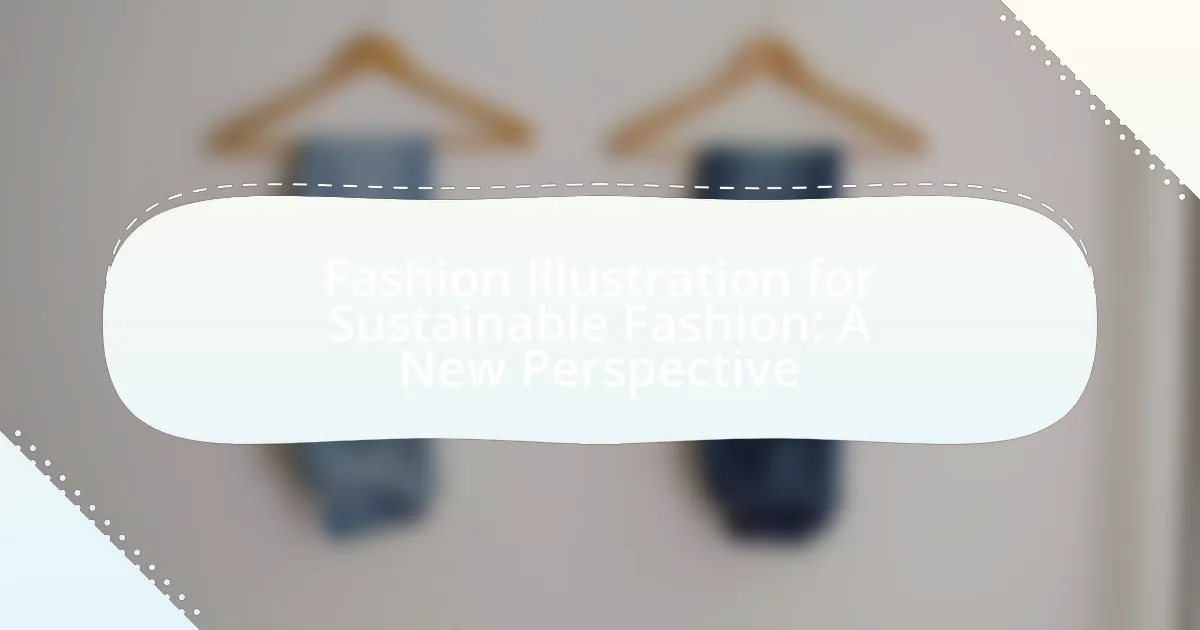Fashion illustration for sustainable fashion is the artistic representation of clothing and accessories that emphasizes eco-friendly practices and materials. This article explores how fashion illustration serves as a visual communication tool to promote sustainable fashion concepts, highlighting the importance of ethical production and environmental responsibility. It discusses various techniques used in sustainable fashion illustration, such as digital methods and eco-friendly materials, and examines how color choices and illustration styles can effectively convey sustainability messages. Additionally, the article addresses the role of fashion illustrators in raising awareness about sustainable practices and the challenges they face in promoting sustainability within the fashion industry.

What is Fashion Illustration for Sustainable Fashion?
Fashion illustration for sustainable fashion is the artistic representation of clothing and accessories that emphasizes eco-friendly practices and materials. This form of illustration serves as a visual communication tool to promote sustainable fashion concepts, showcasing designs that prioritize environmental responsibility, ethical production, and social awareness. By highlighting sustainable materials, such as organic cotton or recycled fabrics, fashion illustrations can influence consumer choices and raise awareness about the impact of fashion on the planet.
How does fashion illustration contribute to sustainable fashion?
Fashion illustration contributes to sustainable fashion by visually communicating eco-friendly design concepts and promoting awareness of sustainable practices. Through detailed representations of sustainable materials and ethical production methods, fashion illustrations can inspire designers and consumers alike to prioritize sustainability in their choices. For instance, illustrations can highlight the use of organic fabrics or zero-waste patterns, making these concepts more accessible and appealing. This visual medium not only educates the audience but also encourages a shift towards more responsible consumption, ultimately fostering a culture of sustainability within the fashion industry.
What techniques are used in sustainable fashion illustration?
Sustainable fashion illustration employs techniques such as digital illustration, eco-friendly materials, and upcycling of existing designs. Digital illustration allows for reduced waste and the ability to easily modify designs, promoting sustainability. Using eco-friendly materials, such as recycled paper and non-toxic inks, minimizes environmental impact. Upcycling involves reimagining and illustrating existing garments, which encourages the reuse of materials and reduces the demand for new resources. These techniques collectively support the principles of sustainability in fashion illustration.
How does fashion illustration communicate sustainability concepts?
Fashion illustration communicates sustainability concepts by visually representing eco-friendly practices and materials in the fashion industry. Through the use of imagery, artists can depict sustainable fabrics, ethical production processes, and the importance of reducing waste, thereby raising awareness among consumers. For instance, illustrations that showcase clothing made from organic cotton or recycled materials highlight the benefits of sustainable choices. Additionally, fashion illustrations can convey messages about the lifecycle of garments, emphasizing the significance of longevity and responsible consumption. This visual storytelling effectively engages audiences, making complex sustainability concepts more accessible and relatable.
Why is sustainable fashion important in today’s industry?
Sustainable fashion is important in today’s industry because it addresses environmental degradation and promotes ethical labor practices. The fashion industry is responsible for approximately 10% of global carbon emissions and significant water pollution, making sustainable practices essential for reducing its ecological footprint. Furthermore, sustainable fashion emphasizes fair wages and safe working conditions, which are critical for improving the lives of garment workers worldwide. By adopting sustainable methods, brands can contribute to a circular economy, reduce waste, and foster consumer awareness about the impact of their purchasing decisions.
What are the environmental impacts of traditional fashion practices?
Traditional fashion practices significantly contribute to environmental degradation through resource depletion, pollution, and waste generation. The fashion industry is responsible for approximately 10% of global carbon emissions, primarily due to energy-intensive production processes and transportation. Additionally, the use of toxic dyes and chemicals in textile manufacturing contaminates water sources, harming aquatic ecosystems. Furthermore, traditional practices often lead to excessive waste, with an estimated 92 million tons of textile waste generated annually, much of which ends up in landfills. These impacts highlight the urgent need for sustainable alternatives in fashion practices.
How does sustainable fashion address these impacts?
Sustainable fashion addresses environmental and social impacts by promoting eco-friendly materials, ethical labor practices, and reduced waste. By utilizing organic fabrics, recycled materials, and sustainable production methods, sustainable fashion significantly lowers carbon emissions and resource consumption. For instance, the use of organic cotton reduces water usage by up to 91% compared to conventional cotton farming. Additionally, sustainable fashion brands often ensure fair wages and safe working conditions for their workers, addressing social inequalities in the garment industry. This holistic approach not only mitigates negative impacts but also fosters a more responsible and conscious consumer culture.

What are the key elements of fashion illustration for sustainability?
The key elements of fashion illustration for sustainability include the use of eco-friendly materials, representation of sustainable practices, and emphasis on timeless design. Eco-friendly materials, such as recycled paper and non-toxic inks, reduce environmental impact during the illustration process. Representation of sustainable practices, such as showcasing ethical production methods and sustainable fabrics, educates consumers about responsible fashion choices. Emphasis on timeless design encourages consumers to invest in quality pieces that last, rather than fast fashion items that contribute to waste. These elements collectively promote awareness and inspire a shift towards sustainable fashion practices.
How do color choices influence sustainable fashion illustrations?
Color choices significantly influence sustainable fashion illustrations by conveying messages about environmental consciousness and ethical practices. For instance, earthy tones like greens and browns often symbolize sustainability and a connection to nature, while vibrant colors can represent innovation and creativity in eco-friendly designs. Research indicates that color psychology plays a crucial role in consumer perception, with studies showing that colors associated with nature can enhance the appeal of sustainable products. This alignment between color and sustainability not only attracts eco-conscious consumers but also reinforces the brand’s commitment to environmental values.
What colors are commonly associated with sustainability?
Green is the color most commonly associated with sustainability, symbolizing nature, growth, and environmental consciousness. This association is reinforced by the prevalence of green in eco-friendly branding and initiatives, where it represents a commitment to sustainable practices. Additionally, earth tones such as brown and beige are also linked to sustainability, as they evoke a connection to the earth and natural materials. Studies show that consumers often perceive these colors as indicative of environmentally responsible products, further solidifying their role in sustainable fashion and design.
How can color psychology enhance the message of sustainability?
Color psychology can enhance the message of sustainability by using specific colors that evoke feelings of nature, health, and eco-friendliness. For instance, green is widely associated with environmental consciousness and growth, making it an effective color to communicate sustainability in fashion illustrations. Research indicates that colors like blue and earthy tones also promote a sense of calm and connection to the environment, reinforcing the sustainable message. A study published in the Journal of Environmental Psychology found that individuals are more likely to support eco-friendly initiatives when presented with green imagery, highlighting the direct impact of color on consumer perception and behavior.
What styles of illustration are most effective for sustainable fashion?
The most effective styles of illustration for sustainable fashion include minimalism, infographics, and hand-drawn aesthetics. Minimalism emphasizes simplicity and clarity, allowing the focus to remain on sustainable materials and practices, which resonates with eco-conscious consumers. Infographics effectively communicate complex information about sustainability metrics, such as carbon footprints and resource usage, making it easier for audiences to understand the impact of their choices. Hand-drawn aesthetics convey authenticity and craftsmanship, aligning with the values of sustainability by highlighting artisanal techniques and the human touch in fashion. These styles collectively enhance the narrative of sustainable fashion, making it more relatable and engaging for the audience.
Which illustration styles resonate with eco-conscious consumers?
Eco-conscious consumers resonate with illustration styles that emphasize natural elements, minimalism, and sustainability. Styles such as botanical illustrations, hand-drawn sketches, and watercolor techniques often appeal to this demographic because they reflect organic aesthetics and a connection to nature. Research indicates that visuals incorporating earthy tones and textures can enhance the perception of eco-friendliness in fashion, as seen in studies like “The Influence of Visual Elements on Consumer Perception of Sustainable Fashion” published in the Journal of Fashion Marketing and Management. This alignment with nature and sustainability in illustration styles reinforces the values of eco-conscious consumers, making these styles particularly effective in communicating sustainable fashion concepts.
How can different styles convey various sustainability messages?
Different styles can convey various sustainability messages by utilizing distinct visual elements, color palettes, and design techniques that resonate with specific environmental themes. For instance, minimalist styles often emphasize simplicity and reduced consumption, aligning with the message of minimal waste. In contrast, vibrant and eclectic styles can highlight the beauty of upcycled materials, promoting creativity in sustainability. Research indicates that visual storytelling in fashion illustration can effectively communicate complex sustainability concepts, making them more accessible to consumers. This approach is supported by studies showing that consumers respond positively to illustrations that reflect their values, such as eco-friendliness and ethical production.

How can fashion illustrators promote sustainable practices?
Fashion illustrators can promote sustainable practices by creating awareness about eco-friendly materials and ethical production methods through their artwork. By showcasing designs that utilize sustainable fabrics, such as organic cotton or recycled materials, illustrators can influence both consumers and designers to prioritize sustainability. Additionally, they can highlight brands that adhere to ethical labor practices, thereby encouraging a shift in consumer behavior towards more responsible fashion choices. Research indicates that visual representation significantly impacts consumer perceptions, making fashion illustrations a powerful tool for advocating sustainable practices in the industry.
What role do fashion illustrators play in raising awareness?
Fashion illustrators play a crucial role in raising awareness about sustainable fashion by visually communicating the principles and practices of eco-friendly design. Their illustrations can highlight sustainable materials, ethical production processes, and the importance of reducing waste, making complex concepts accessible to a broader audience. For instance, campaigns like “Fashion Revolution” utilize illustrations to engage consumers and promote transparency in the fashion industry, effectively educating the public on the environmental impact of their clothing choices. This visual storytelling not only captures attention but also inspires action towards more sustainable practices in fashion consumption.
How can illustrators collaborate with sustainable brands?
Illustrators can collaborate with sustainable brands by creating visual content that aligns with the brand’s eco-friendly values and mission. This collaboration can involve designing packaging, promotional materials, or social media graphics that highlight the sustainable aspects of the brand’s products. For instance, illustrators can depict the use of organic materials or ethical production processes, thereby enhancing the brand’s storytelling and consumer engagement. Research indicates that visual storytelling significantly influences consumer perception, with studies showing that 65% of people are visual learners, making illustrations a powerful tool for conveying sustainability messages effectively.
What platforms can illustrators use to share their sustainable work?
Illustrators can use platforms such as Instagram, Behance, and Pinterest to share their sustainable work. Instagram allows for visual storytelling and engagement with a broad audience, making it ideal for showcasing sustainable fashion illustrations. Behance serves as a portfolio platform where illustrators can present their projects in detail, attracting potential clients and collaborators interested in sustainability. Pinterest functions as a visual discovery tool, enabling illustrators to reach users searching for sustainable fashion inspiration. These platforms collectively enhance visibility and foster community around sustainable practices in fashion illustration.
What are the challenges faced by fashion illustrators in promoting sustainability?
Fashion illustrators face several challenges in promoting sustainability, primarily due to the industry’s entrenched practices and consumer perceptions. One significant challenge is the lack of awareness among consumers regarding sustainable fashion, which limits the impact of illustrations that advocate for eco-friendly choices. Additionally, fashion illustrators often encounter resistance from brands that prioritize profit over sustainability, making it difficult to align their artistic vision with sustainable practices. Furthermore, the fast-paced nature of the fashion industry can undermine efforts to promote long-term sustainable solutions, as trends shift rapidly, often overshadowing sustainable initiatives. These challenges highlight the need for greater collaboration between illustrators, brands, and consumers to foster a more sustainable fashion ecosystem.
How can illustrators overcome these challenges?
Illustrators can overcome challenges in sustainable fashion by adopting innovative techniques and collaborating with eco-conscious brands. By utilizing digital tools, illustrators can reduce waste associated with traditional materials and streamline their creative processes. Collaborating with sustainable fashion brands allows illustrators to align their work with environmentally friendly practices, ensuring that their illustrations reflect the values of sustainability. Additionally, staying informed about sustainable materials and practices enables illustrators to create more relevant and impactful artwork, which resonates with an audience increasingly concerned about environmental issues.
What resources are available for illustrators focused on sustainability?
Illustrators focused on sustainability can access various resources, including online platforms, workshops, and publications dedicated to eco-friendly practices. Websites like EcoArtSpace and the Sustainable Arts Foundation provide information and funding opportunities for artists committed to sustainability. Additionally, organizations such as the Association of Illustrators offer resources and guidelines on sustainable practices in illustration. Workshops and webinars hosted by environmental organizations often cover sustainable materials and techniques, further supporting illustrators in their efforts to create environmentally conscious artwork.
What are some best practices for fashion illustrators in sustainable fashion?
Fashion illustrators in sustainable fashion should prioritize eco-friendly materials and techniques in their work. Utilizing digital illustration tools reduces paper waste and allows for easy revisions, promoting sustainability. Additionally, incorporating sustainable fashion concepts into illustrations, such as using organic fabrics or ethical production methods, helps raise awareness and educate consumers. Collaborating with sustainable brands can also enhance the visibility of eco-conscious practices within the fashion industry. Research indicates that visual representation significantly influences consumer behavior, making it crucial for illustrators to depict sustainability accurately and attractively.
How can illustrators ensure their materials are eco-friendly?
Illustrators can ensure their materials are eco-friendly by selecting sustainable options such as recycled paper, non-toxic inks, and biodegradable adhesives. Using recycled paper reduces deforestation and energy consumption, while non-toxic inks minimize harmful chemical exposure and environmental pollution. Biodegradable adhesives contribute to reducing landfill waste. According to the Environmental Protection Agency, recycling paper can save 60% of the energy required to produce new paper from raw materials, highlighting the environmental benefits of these choices.
What tips can illustrators follow to effectively communicate sustainability?
Illustrators can effectively communicate sustainability by incorporating eco-friendly themes and practices into their artwork. They should use imagery that highlights sustainable materials, such as organic fabrics or recycled products, to visually represent the concept of sustainability. Additionally, employing a color palette inspired by nature can evoke environmental consciousness. Research indicates that visuals significantly influence consumer perceptions; for instance, a study published in the Journal of Consumer Research found that images depicting sustainable practices can enhance brand credibility and consumer trust. By integrating these elements, illustrators can create compelling narratives that resonate with audiences and promote sustainable fashion.

Leave a Reply